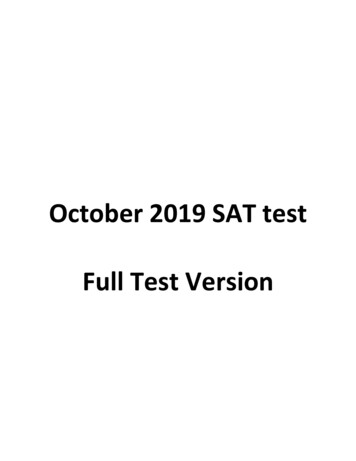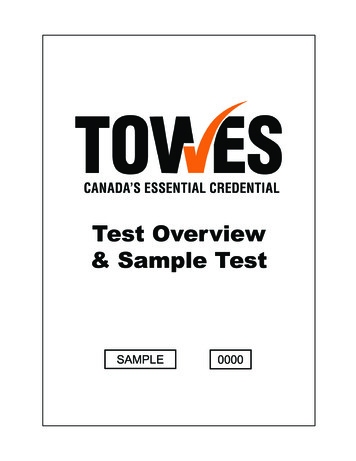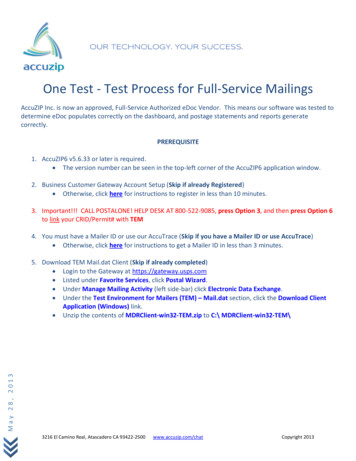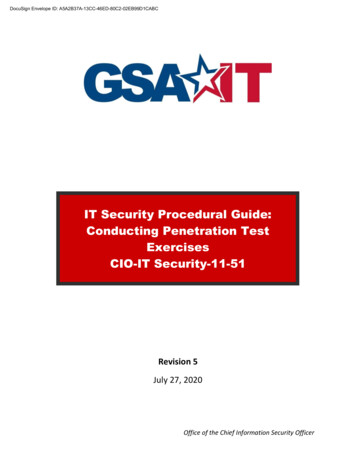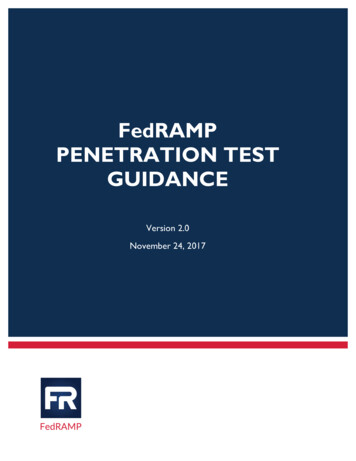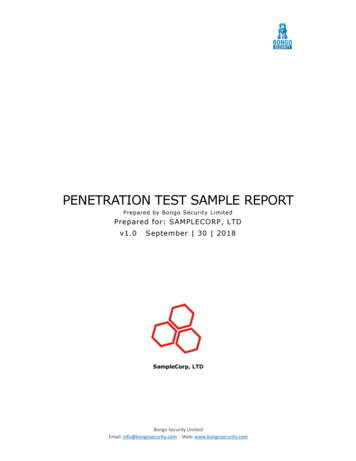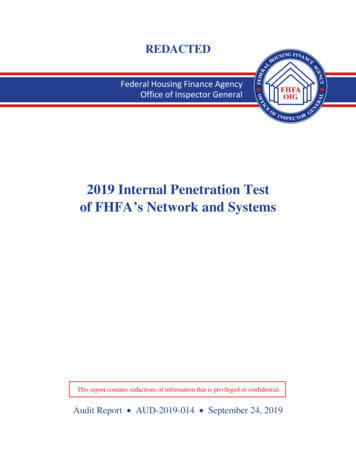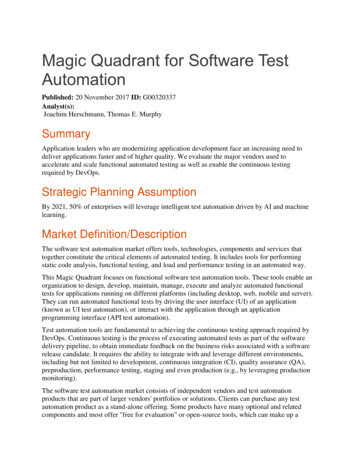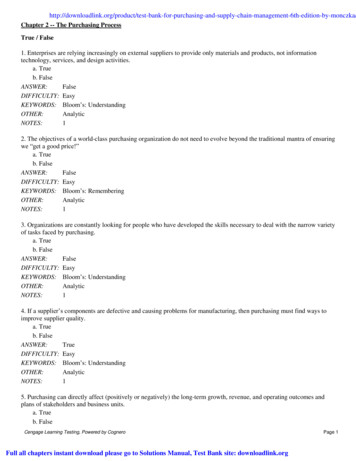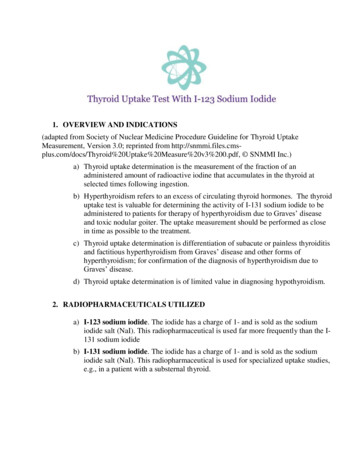
Transcription
1. OVERVIEW AND INDICATIONS(adapted from Society of Nuclear Medicine Procedure Guideline for Thyroid UptakeMeasurement, Version 3.0; reprinted from ke%20Measure%20v3%200.pdf, SNMMI Inc.)a) Thyroid uptake determination is the measurement of the fraction of anadministered amount of radioactive iodine that accumulates in the thyroid atselected times following ingestion.b) Hyperthyroidism refers to an excess of circulating thyroid hormones. The thyroiduptake test is valuable for determining the activity of I-131 sodium iodide to beadministered to patients for therapy of hyperthyroidism due to Graves’ diseaseand toxic nodular goiter. The uptake measurement should be performed as closein time as possible to the treatment.c) Thyroid uptake determination is differentiation of subacute or painless thyroiditisand factitious hyperthyroidism from Graves’ disease and other forms ofhyperthyroidism; for confirmation of the diagnosis of hyperthyroidism due toGraves’ disease.d) Thyroid uptake determination is of limited value in diagnosing hypothyroidism.2. RADIOPHARMACEUTICALS UTILIZEDa) I-123 sodium iodide. The iodide has a charge of 1- and is sold as the sodiumiodide salt (NaI). This radiopharmaceutical is used far more frequently than the I131 sodium iodideb) I-131 sodium iodide. The iodide has a charge of 1- and is sold as the sodiumiodide salt (NaI). This radiopharmaceutical is used for specialized uptake studies,e.g., in a patient with a substernal thyroid.
3. CHARACTERISTICS OF THE RADIONUCLIDESI-123a) Iodine-123 decays by electron capture with a physical half-life of 13.2 hours.Photons used for detection and imaging of I-123 have an energy of 159 KeV.b) The specific gamma ray constant for I-123 is 1.6 R/hr-mCi at 1 cm.c) The first half-value thickness of lead (Pb) for I-123 is 0.005 cm and the first tenthvalue layer is 0.54 cm of Pb.d) Decay SchemeAdapted from www.nucleonica.comI-131a) Iodine I-131 decays by beta emission and associated gamma emission with a physicalhalf-life of 8.04 days. Photons used for detection and imaging of I-131 have anenergy of 364.4 KeV.b) The specific gamma-ray constant for iodine I-131 is 2.2 R/hr-millicurie at 1cm.c) The first half-value thickness of lead (Pb) for iodine I-131 is 3 mm and the first tenthvalue layer is 11 mm of Pb.d) Decay SchemeAdapted fromwww.nucmedtutorials.com
4.DRUG AVAILABILITYa) Both radiopharmaceuticals are readily available from any central Radiopharmacy.5. MOLECULAR STRUCTURESa) Sodium iodide is an ionic compound containing Na1 and I1- ions. It really doesn’thave a molecular structure, although there is a crystal lattice structure that hasbeen well-characterized.6. DRUG PREPARATIONa) None required- each dose is precalibrated by the central pharmacy for a specificpatient.7. QUALITY CONTROL PROCEDURESa) None required- requisite quality control procedures are performed by the centralpharmacy prior to shipping doses of any of these radiopharmaceuticals.8. RADIOCHEMICAL REACTIONS RELATED TO DRUG PREPARATION.a) None required9. CLINICAL PHARMACOLOGYa) Sodium iodide (I-123 or I-131)i. Iodide is readily absorbed from the upper gastrointestinal tract. Followingabsorption, the iodide is distributed primarily within the extracellular fluid ofthe body. It is trapped and organically bound by the thyroid and concentratedby the stomach, choroid plexus and salivary glands. It is excreted by thekidneys. The fraction of the administered dose which is accumulated in thethyroid gland may be a measure of thyroid function in the absence ofunusually high or low iodine intake or administration of certain drugs whichinfluence iodine accumulation by the thyroid gland. Accordingly, the patientshould be questioned carefully regarding previous medications and/orprocedures involving radiographic media.
ii. Normal subjects can accumulate approximately 8 to 35% of the administerediodine dose in the thyroid gland, however, the normal and abnormal ranges areestablished by individual physician’s criteria. The mapping (imaging) ofsodium iodide I-123 distribution in the thyroid gland may provide usefulinformation concerning thyroid anatomy and definition of normal and/orabnormal functioning of tissue within the gland.iii. Trapped iodide is oxidized to iodine and organically incorporated so rapidlythat the iodide trap of the thyroid contains less than 0.2% free iodide incomparison to the organically bound iodine. This process results in furtherconcentration of iodine in the thyroid gland to about 500 times that in theblood. The iodinated organic compounds chiefly consist of thyroxine (T4) andtriiodothyronine (T3), which are bound by thyroglobulin in the follicularcolloid. T4 and T3 are released by enzymatic proteolysis of thyroglobulin intothe blood where they are specifically bound and transported by plasma thyroidbinding proteins. These reactions are primarily under the control of anteriorpituitary gland release of thyroid stimulating hormone (TSH) andhypothalamic thyroid release factor (TRF).iv. Iodide is excreted by the kidneys. The normal range of urinary excretion is 3775% of the administered dose; varies with the renal function of the patient.9. MECHANISM OF LOCALIZATION OF RADIOPHARMACEUTICAL:a) The mechanism of localization is referred to as Active Transport. This is defined asutilization of a normally active, energy-dependent metabolic pathway in the body totransport a radiopharmaceutical across a cell membrane and into the cell. In the caseof the radioiodides, the iodide is first trapped, then undergoes intermediate synthesesinvolving a thyroglobulin intermediate, and is first organified into T1 then stepwiseinto T2 then T3 and finally T4. Each of these iodination steps is energy dependent, ofprimary importance in meeting the requirements of a normally active, energydependent metabolic pathway.10. NORMAL DISTRIBUTION OF DRUG(target organ organs receiving highest radiation dose);adapted from hyroid gland (target organ)nasopharynxsalivary glandsstomach (target organ)colon
f) bladder (target organ)g) lactating breasts11. NORMAL RANGE OF THYROID UPTAKE OF IODIDE: AVERAGE VALUESa) 8% hypothyroid; 8-35% euthyroid; 35% hyperthyroid.b) The euthyroid range varies from 8-10 on the low end to 30-35 on the highend.12. TYPICAL ADMINISTERED DOSE FOR UPTAKE STUDIESa) The recommended adult dose of I-123 sodium iodide for thyroid uptake is 200 Ci (7.4 MBq) , administered orally, and for thyroid scintigraphy is 200 to 400 Ci (7.4 to 14.8 MBq).b) Use of I-131 is strongly discouraged for routine use because of its much greaterradiation dose to the thyroid. If it is required, however, the dose should notexceed 100 Ci.13. PATIENT PREPARATION FOR THYROID UPTAKE WITH I-123 NaIa) It is very important to carefully interview the patient prior to administration of theI-123 sodium iodide as there are so many potential interferences in the uptakeprocedure that could invalidate the results. Included are the following:i. Is the patient pregnant or lactating?ii. Is the patient taking any herbal supplements, as they may also affect the testresults?iii. Has the patient received iodine-containing contrast (e.g. for CT or angiography)?iv. Is the patient consuming substances that contain iodine, including kelp, seaweed,seafood, cough syrups, multivitamins or heart medications can interfere with bothuptake and scan?v. Is the patient taking any of the medications on the “Interfering Medications List”?Medications that interfere with thyroid uptake of radioiodine could delay theprocedure for up to 4 weeks.vi. It might be necessary to perform blood tests to measure the level of thyroidhormones in the patient’s blood.vii. Jewelry and other metallic accessories in the region of the thyroid should beremoved prior to the exam because they may interfere with the procedure.b) Patients should be fasted for 4 hours prior to and for 1-2 hours after receiving thecapsule.
14. DRUG ADMINISTRATION PROCEDUREa) I-123 NaI and I-131 NaIi. Capsule is taken orally with a cup of water. Patient must remain NPO for atleast 1 hour.15. COUNTING PROTOCOLS(adapted from Society of Nuclear Medicine Procedure Guideline for Thyroid UptakeMeasurement, Version 3.0, approved September 5, 2006; reprinted 0Uptake%20Measure%20v3%200.pdf, SNMMI Inc.)a) A sodium iodide (NaI) crystal uptake probe with suitable lead shielding and a flatfield collimator should be used. This is usually integrated with a multiple channelanalyzer and recording computer.b) The measurement of thyroid uptake is usually performed 18–24 hr afteradministration of the radioiodine. In some circumstances, it may be performedbetween 2 and 6 hr after radioiodine ingestion, as well. The uptake is usuallymeasured with 25– 30 cm between the face of the crystal and the anterior neck orphantom. Neck counts, lower thigh counts (body background), counts of acalibrated standard in a neck phantom and room background counts arepreferably obtained at each counting session. Alternatively, the radioiodine dosecan be counted in the neck phantom before oral administration, and the countsobtained can be corrected for decay at each patient counting session. The ORINS,IAEA or a comparable neck phantom is recommended.c) Thyroid uptake can alternatively be measured using a scintillation camera, LEAPcollimator and appropriate regions of interest. Validation of gamma cameratechniques by comparison with a reliable standard is recommended.15. ADVERSE REACTIONS ASSOCIATED WITH RADIOPHARMACEUTICALSUSED FOR THYROID IMAGINGa) Although very rare, reactions associated with the administration of I-123 sodiumiodide for diagnostic use include, in decreasing order of frequency, nausea,vomiting, chest pain, tachycardia, itching skin, rash and hives.b) Adverse reactions that have been reported with doses of sodium iodide I-131 usedin the treatment of benign disease include sialadenitis, chest pain, tachycardia,iododerma, itching skin, rash, hives, hypothyroidism, hyperthyroidism, thyrotoxiccrisis, hypoparathyroidism, and local swelling.
MEDICATIONS AND FOODS THAT AFFECT THYROID UPTAKETESTThe following chart indicates which drugs and foods may interfere with thyroid uptake andmay affect image quality. Source: ded duration ofMedicationwithdrawalAdrenocorticosteroids1 weekBromides1 weekButazolidine1 weekMercurials1 weekMethimazole (Tapazole)1 weekNitrates1 weekPerchlorate1 weekPropylthiouracil1 weekSalicylates (large doses)1 weekSulfonamides1 weekThiocyanate1 weekTri-iodothyronine (Cytomel)2 to 3 weeksThyroid extract (Synthroid)4 weeksIodine solution (Lugol’s, SSKI)Iodine containing foods: iodized salt, dairy products, eggyolks, seafood, turkey, and liverIodine-containing antisepticsweeks2 weeksweeksKelp4 weeksSome cough medicines4 weeksSome Vitamin preparations4 weeksIntravenous contrast agents1 to 2 monthsOil-based iodinated contrast3 to 6 monthsAmiodarone3 to 6 months
16. CONTRAINDICATIONSa) To date there are no known contraindications to the use of I-123 Sodium Iodideor Tc-99m pertechnetate except for pregnancy or breastfeeding.17. INTERNAL RADIATION DOSIMETRYi. I-123 and I-131 sodium iodide: The estimated absorbed radiation doses toseveral organs of an average patient (70 kg) from oral administration of 400 μCiof I-123 are shown in the table below for thyroid uptakes of 5, 15, and 25%. Forcomparison at these three values of thyroid uptake, the estimated radiation dosesfrom a dose of 100 μCi I-131, also used as thyroid imaging agent, are alsoincluded.
19. RADIOACTIVE IODINE UPTAKE TEST (RAIU) CALCULATIONSa) The question answered by the % uptake value is, what percent of the I-123 NaI inthe capsule accumulates in the thyroid gland at 24 hr post administration of the dose?b) The formula used for calculation is% Uptake (Net Counts/Min in Thyroid) X 100%Decay-Corrected Net Counts/Min in Capsulec) Radioactive Iodine Uptake Test: Sample ProblemA capsule of I-123 NaI was counted at T0. Patient then swallowed capsuleand returned at 24 hr for counting.(T1/2 13.3 hr; 24 hr decay factor: 0.2863)Patient background:1,000 counts/5 minCapsule background:1,000 counts/5 minThyroid counts At T24: 50,000 counts/2 minCapsule counts At T0: 300,000 counts/2 minWhat is % RAIU?If patient and capsule are counted at the same time, then decay correction can be ignored.d) Solution to problem% UPTAKE (Net Counts/Min in Thyroid) X 100%Decay-Corrected Net Counts/Min in Capsule% UPTAKE (25,000-200) X 100%(150,000-200) X 0.2863% UPTAKE 58.7%DIAGNOSIS: Hyperthyroid
20. MISCELLANEOUS INFORMATIONa) 30-35 years ago, the upper end of the normal range of thyroid uptake was 35-40%.Now it is 30-35%. The main cause for this decrease is the ubiquitous presence ofiodized salt in many foods that we eat, as well as increased consumption of seafood,especially ocean fish, and sushi which contains seaweed, a significant source ofiodine.b) Inderal (propranolol) and most other beta-blockers do not interfere with thyroiduptake tests. They are frequently prescribed for hyperthyroid patients to keep theirpulse rates at acceptable levels.
uptake test is valuable for determining the activity of I-131 sodium iodide to be administered to patients for therapy of hyperthyroidism due to Graves’ disease and toxic nodular goiter. The uptake measurement should be performed as close in time as possible to the treatment. c) Thyroid uptake determination is differentiation of subacute or painless thyroiditis and factitious hyperthyroidism

